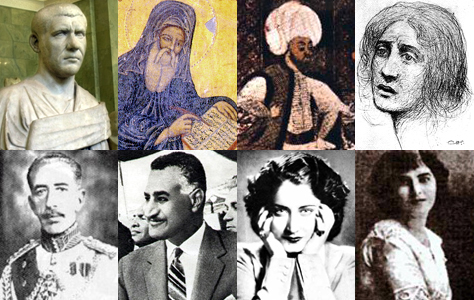 |
This is a file from the Wikimedia Commons. Information from its description page there is shown below.
Commons is a freely licensed media file repository. You can help.
|
Summary
| DescriptionArab infobox.jpg |
Notable Arabs for the infobox. From left to right: Philippus Arabus, John of Damascus, al-Kindi, al-Khansa, King Faisal I, Gamal Abdel Nasser, Asmahan, and May Ziade.
|
| Date |
See individual images. |
| Source |
|
| Author |
See individual images. Compiled by User:FunkMonk. |
Licensing
I, George Shuklin, the copyright holder of this work, hereby publishes it under the following licenses:
 |
Permission is granted to copy, distribute and/or modify this document under the terms of the GNU Free Documentation License, Version 1.2 or any later version published by the Free Software Foundation; with no Invariant Sections, no Front-Cover Texts, and no Back-Cover Texts. A copy of the license is included in the section entitled GNU Free Documentation License. http://www.gnu.org/copyleft/fdl.htmlGFDLGNU Free Documentation Licensetruetrue
|

 |
This file is licensed under the Creative Commons Attribution 2.5 Generic license. |
|
| Attribution: I, George Shuklin |
- You are free:
- to share – to copy, distribute and transmit the work
- to remix – to adapt the work
- Under the following conditions:
- attribution – You must attribute the work in the manner specified by the author or licensor (but not in any way that suggests that they endorse you or your use of the work).
http://creativecommons.org/licenses/by/2.5 CC-BY-2.5 Creative Commons Attribution 2.5 truetrue
|
You may select the license of your choice.
|
This is a faithful photographic reproduction of an original two-dimensional work of art. The work of art itself is in the public domain for the following reason:
| Public domainPublic domainfalsefalse |
 |
This image (or other media file) is in the public domain because its copyright has expired.
This applies to Australia, the European Union and those countries with a copyright term of life of the author plus 70 years.
 You must also include a United States public domain tag to indicate why this work is in the public domain in the United States. Note that a few countries have copyright terms longer than 70 years: Mexico has 100 years, Colombia has 80 years, and Guatemala and Samoa have 75 years, Russia has 74 years for some authors. This image may not be in the public domain in these countries, which moreover do not implement the rule of the shorter term. Côte d'Ivoire has a general copyright term of 99 years and Honduras has 75 years, but they do implement the rule of the shorter term. You must also include a United States public domain tag to indicate why this work is in the public domain in the United States. Note that a few countries have copyright terms longer than 70 years: Mexico has 100 years, Colombia has 80 years, and Guatemala and Samoa have 75 years, Russia has 74 years for some authors. This image may not be in the public domain in these countries, which moreover do not implement the rule of the shorter term. Côte d'Ivoire has a general copyright term of 99 years and Honduras has 75 years, but they do implement the rule of the shorter term.
|
|
This file has been identified as being free of known restrictions under copyright law, including all related and neighboring rights.
|
The official position taken by the Wikimedia Foundation is that "faithful reproductions of two-dimensional public domain works of art are public domain, and that claims to the contrary represent an assault on the very concept of a public domain". For details, see Commons:When to use the PD-Art tag.
This photographic reproduction is therefore also considered to be in the public domain. Please be aware that depending on local laws, re-use of this content may be prohibited or restricted in your jurisdiction. See Commons:Reuse of PD-Art photographs.
{{ PD-Art}} template without parameter: please specify why the underlying work is public domain in both the source country and the United States
(Usage: {{PD-Art|1=|deathyear=|country=|date=}}, where parameter #1 can be PD-old-auto, PD-old-auto-1923, PD-old-100 or similar)
|
| Public domainPublic domainfalsefalse |
 |
This image (or other media file) is in the public domain because its copyright has expired.
This applies to Australia, the European Union and those countries with a copyright term of life of the author plus 70 years.
 You must also include a United States public domain tag to indicate why this work is in the public domain in the United States. Note that a few countries have copyright terms longer than 70 years: Mexico has 100 years, Colombia has 80 years, and Guatemala and Samoa have 75 years, Russia has 74 years for some authors. This image may not be in the public domain in these countries, which moreover do not implement the rule of the shorter term. Côte d'Ivoire has a general copyright term of 99 years and Honduras has 75 years, but they do implement the rule of the shorter term. You must also include a United States public domain tag to indicate why this work is in the public domain in the United States. Note that a few countries have copyright terms longer than 70 years: Mexico has 100 years, Colombia has 80 years, and Guatemala and Samoa have 75 years, Russia has 74 years for some authors. This image may not be in the public domain in these countries, which moreover do not implement the rule of the shorter term. Côte d'Ivoire has a general copyright term of 99 years and Honduras has 75 years, but they do implement the rule of the shorter term.
|
|
This file has been identified as being free of known restrictions under copyright law, including all related and neighboring rights.
|
| Public domainPublic domainfalsefalse |
|
|
This media file is in the public domain in the United States. This applies to U.S. works where the copyright has expired, often because its first publication occurred prior to January 1, 1923. See this page for further explanation.
|
|
|
|
This image might not be in the public domain outside of the United States; this especially applies in the countries and areas that do not apply the rule of the shorter term for US works, such as Canada, Mainland China (not Hong Kong or Macao), Germany, Mexico, and Switzerland. The creator and year of publication are essential information and must be provided. See Wikipedia:Public domain and Wikipedia:Copyrights for more details. |
|
| Public domainPublic domainfalsefalse |
 |
This work was first published in Iraq and is now in the public domain because its copyright protection has expired by virtue of the Law No. 3 of 1971 on Copyright, amended 2004 by Order No. 83, Amendment to the Copyright Law. The work meets one of the following criteria:
- It is an anonymous work or pseudonymous work and 50 years have passed since the year of its publication
- It is a work where the copyright holder is a legal entity or a work of applied art 50 years have passed since the year of its publication
- It is a photographic or cinematic work that is not compositive (artistic in nature) first published before 1 January 1999
- It is work published in Iraq before 1 January 1954, and the author died before 1 January 1979
- It is another kind of work, and 50 years have passed since the year of death of the author (or last-surviving author)
- It is one of "collections of official documents, such as texts of international laws, regulations and agreements, judicial judgements and various official documents."
English | +/−
|
|

 |
Per U.S. Circ. 38a., the following countries are not a participant in the Berne Convention or any other treaty on copyright with the United States:
- Afghanistan, Eritrea, Ethiopia, Iran, Iraq, Kiribati, Nauru, Palau, San Marino, São Tomé and Príncipe, the Seychelles, Somalia, Turkmenistan and Tuvalu.
As such, works published by citizens of these countries in these countries are usually not subject to copyright protection outside of these countries. Hence, such works may be in the public domain in most other countries worldwide.
- However
- Works published in these countries by citizens or permanent residents of other countries that are signatories to the Berne Convention or any other treaty on copyright will still be protected in their home country and internationally as well as locally by local copyright law.
- Similarly, works published outside of these countries within 30 days of publication within these countries will also usually be subject to protection in the foreign country of publication. When works are subject to copyright outside of these countries, the term of such copyright protection may exceed the term of copyright inside them.
- Unpublished works from these countries may be fully copyrighted.
Iraq has enacted Law No. 3 of 1971 on Copyright (Arabic) which came into force on 21 January 1971. Iraq has enacted Regulation No. 10 of 1985 on the National Committee for the Protection of Copyright (Arabic) which came into force on 2 September 1985. Iraq has enacted Order No. 83, Amendment to the Copyright Law (Arabic) ( Unofficial English (WIPO) translation) which came into force on 1 May 2004. |
| Public domainPublic domainfalsefalse |
 |
This Egyptian work is currently in the public domain in Egypt because its copyright has expired pursuant to the provisions of Intellectual Property Law 82 of 2002. The 2002 law, which repealed Copyright Law 354 of 1954, was not retroactive, meaning that works which had already fallen into the public domain in 2002 remain out-of-copyright in Egypt. In order to be hosted on Commons, all works must be in the public domain in the United States as well as in their source country. Egyptian works that are currently in the public domain in the United States are those whose copyright had expired in Egypt on the U.S. date of restoration (January 1, 1996) pursuant to the provisions of the old 1954 law which was in effect at the time.
| Type of work |
Copyright has expired in Egypt if... |
Copyright has expired in the U.S. if... |
| A |
Non-creative photographic or audiovisual works |
published prior to 1987 |
published prior to 1981 |
| B |
Other works with an identifiable author |
the author died prior to 1963 |
the author died prior to 1946 |
| C |
Other works that are either anonymous or pseudonymous |
published prior to 1963 |
published prior to 1946 |
| D |
Other works (e.g. collective works) whose copyright is held by a legal person |
published prior to 1963 |
published prior to 1946 |
 Certain types of Egyptian works (official documents, stamps, works of national folklore) should use specific license tags instead of this generic tag. Certain types of Egyptian works (official documents, stamps, works of national folklore) should use specific license tags instead of this generic tag.
|
 |
File usage
The following pages on Schools Wikipedia link to this image (list may be incomplete):
This file contains additional information, probably added from the digital camera or scanner used to create or digitize it. If the file has been modified from its original state, some details may not fully reflect the modified file.
SOS Children has brought Wikipedia to the classroom. The world's largest orphan charity, SOS Childrens Villages brings a better life to more than 2 million people in 133 countries around the globe. Why not try to find out more about sponsoring a child?


















